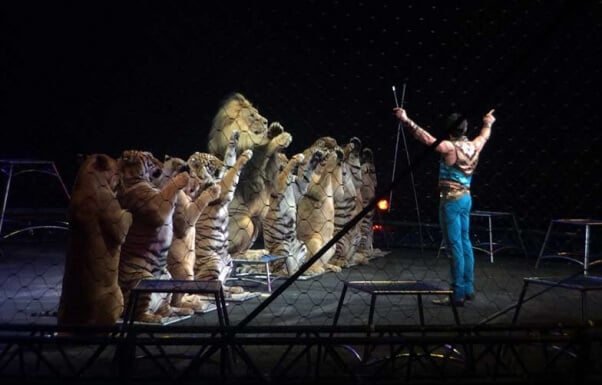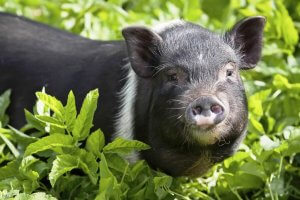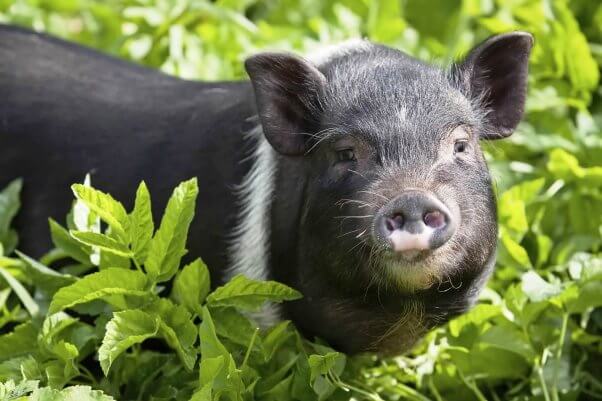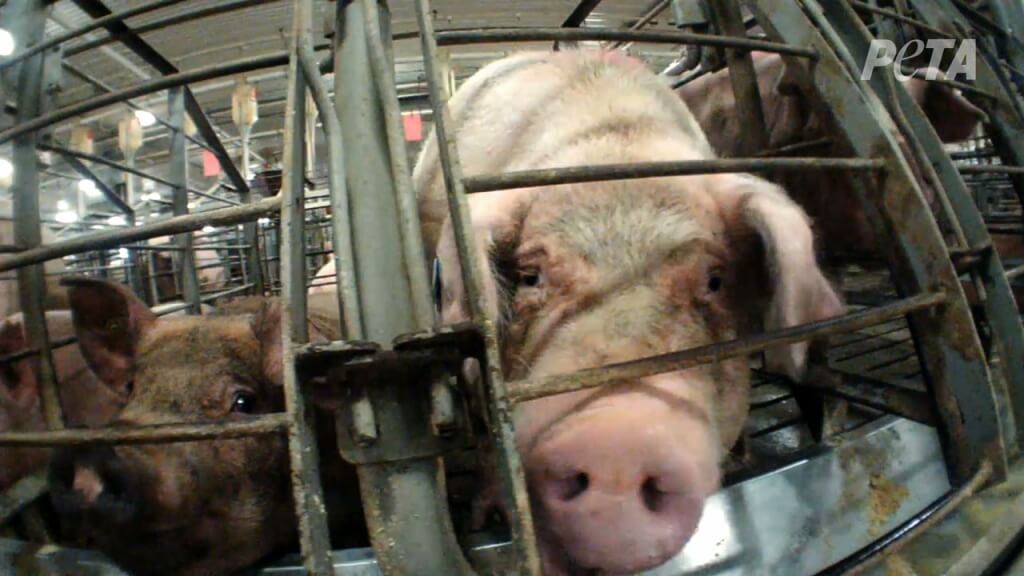
The post Heatstroke and Neglect Killed This Pit Bull—but There’s Still Time to Save Others appeared first on PETA.

respect nature & human rights

The post Heatstroke and Neglect Killed This Pit Bull—but There’s Still Time to Save Others appeared first on PETA.

It may come as a surprise to most people that PETA loves the circus.
What PETA doesn’t love is to see animals forced to spend a lifetime in chains and cramped cages, in boxcars and basements—torn from their families and denied all freedom so that they can be forced to perform tricks that fatten someone’s bottom line. In the end, faced with the photos and videos of how these wild animals fare in captivity, most people agreed with us.
Ringling Bros. and Barnum & Bailey Circus has dragged what used to be called its “beast wagons” from town to town since 1871, but the tent pegs are being pulled up for the last time. Ringling will go dark after its May 21 performance in Uniondale, New York.

Circuses around the world that beat Ringling to the punch in making the decision to stop using animals are thriving. But Ringling stonewalled for decades, hoping that the mounting protests by people who care about animals’ welfare—PETA members and supporters, other animal rights organizations and grassroots groups that challenged the circus at every stop in every city—would somehow disappear. It was a terrible miscalculation.
So, whether it was simple denial or sheer hubris, Ringling clung to its cruel, archaic business model even as its attendance figures reached rock bottom. It’s hard to fathom now all the things that it long defended. For example, PETA exposed how the circus broke the spirit of baby elephants—they were torn from their frantic, loving mothers and forced to stand on crippling concrete for up to 23 hours a day. Tied by all four legs, they were shocked with electric prods and beaten with heavy, steel-tipped bullhooks until they learned to obey out of fear.

Elephant calf coerced into an unnatural posture using bullhooks and ropes at the Center for Elephant Conservation.
Video shot during a PETA investigation showed Ringling trainers beating adult elephants in the face as they were lining up obediently before a performance.
Last year, an animal behaviorist with 25 years’ experience released a scathing report documenting the dire physical condition of tigers used by Ringling.
Astoundingly, even after Ringling’s parent company, Feld Entertainment, paid a $270,000 fine—the largest penalty in circus history—to settle multiple violations of the federal Animal Welfare Act, Ringling continued to defend the indefensible. A few years later, though, a crack appeared in the façade.
Citing a public “mood shift,” in March 2015 the circus announced that it would pull elephants off the road by 2018, a decision that was also prompted by bullhook bans in municipalities across the country as well as ordinances banning circuses and other acts that use wild and exotic animals.
But while the public supported Ringling’s long-overdue decision, few people were satisfied. After all, it wasn’t just elephants who suffer in the circus. And those who knew the elephants’ plight, weren’t going to rest while elephants, some lame, were still going to be hauled around the country for another three years. More than a quarter-million people signed a PETA petition calling for the elephants to be taken off the road immediately. Demonstrations were held at every venue.
Finally, Ringling caved. It pulled its elephant acts in May 2016. They didn’t go to a sanctuary, though, despite calls for that to happen. Instead, they went to Ringling’s Florida breeding compound, where they are still chained—typically by one foreleg and one hind leg so that they can’t move more than a step or two in any direction.
What does the collapse of “The Saddest Show on Earth” portend for UniverSoul Circus, Carson & Barnes Circus, Carden Circus International and other old-style animal circuses and traveling shows? The same thing it portends for SeaWorld, the Miami Seaquarium and other marine parks, where orcas and dolphins float listlessly in tiny, barren, concrete tanks: Unless they evolve by leaving out animal acts, their days are numbered, too.
Some of them are already starting to get the picture.
The Rochester, New York, Shriners dropped their circus after more than 80 years because it was losing money; the Ramos Bros. Circus, which this year eliminated all animal acts except for dogs, is now drawing massive crowds; and the National Aquarium is sending its bottlenose dolphins to a seaside sanctuary where they will experience some semblance of a natural life. “Times have changed, and our understanding of the needs of the animals in our care has changed,” one official said.
The owners of Circus Vargas gave a similar reason when they dropped animal acts in 2010. “We felt the time was coming for a change.”
Thanks to an educated public, yes—the time has come.
The post The Curtain Comes Down on Ringling appeared first on PETA.

I didn’t choose the slug life, the slug life chose me. It all started when a tawny-colored slug showed up on my porch when I was 4 years old. Instantly enamored, I gave him a name that only a kid could love: Foo Foo. I loved Foo Foo and considered him my first companion animal. I even built him a Lincoln Log cabin to live in, but much to my chagrin, he preferred my mom’s container garden. Most mornings, I’d see a glistening trail that I assumed led back to Foo Foo’s wife and kids.
Everything was fine in our world until one fateful family gathering. Word in the yard was that my uncle was going to do a magic trick. Magic? Yes, please! Elbowing my way through a gaggle of gangly arms and legs five cousins deep, I arrived just in time to hear my uncle say “abracadabra” and sprinkle salt on Foo Foo. I watched in horror as my Foo Foo melted into a sickening, greasy stain. I was inconsolable.
Foo Foo’s cruel death had a profound effect on me. It awakened my compassion and sparked a belief in the sanctity of all life. I became a bug bouncer, gently escorting insects from my house. No slug was ever again killed with salt or drowned in beer on my watch. I grew into a shooer instead of a squisher. To this day, I’m still awfully fond of slugs.
They are so fascinating. Did you know that slugs are actually mollusks as well as hermaphrodites? Having both sex organs allows each slug to lay eggs. Beneficial to the environment, slugs process decaying plants, turning them back into soil. And much like us, they analyze data to make such decisions as what to eat, with whom to mate and how to avoid danger.
They are also extremely active in the fall. So as autumn turns the trees into a riot of colors, we can expect to see four things: meteorologists overusing the word “brisk,” pumpkin-flavored everything, slugs laying their eggs in gardens and insects entering houses to wait out the winter. The good news is that there’s no need to resort to cruel methods to have a slug-free garden or an insect-free home.
Slugs are nocturnal and thrive in damp conditions, so refrain from watering your garden in the evening. This simple tactic alone can decrease slug damage by 80 percent. Installing granite rock around your garden and placing mint, lemon balm, pine needles, cosmos, sage or parsley in your garden will also deter any mollusks with the munchies.
If ants start moving into your house like they’ve rented it on Airbnb, find their point of entry and pour a line of cinnamon, red chili powder or paprika—they won’t cross it. To prevent stink bugs from sneaking in, remove window air conditioners and apply weather stripping around doors and windows. Spiders hate citrus, so rub a lemon peel on door and window frames to deter them. Place catnip sachets or bay leaves on top of shelves and other high surfaces to keep cockroaches away.
Like all animals, slugs and other tiny beings who are perceived as “pests” suffer when they are poisoned, trapped, drowned or otherwise killed. As Alan Gelperin, a researcher who has studied the memory and learning abilities of slugs, says, “Before you step on a slug, or sprinkle the poison, pause and consider the creature’s marvelous complexity and place in the scheme of things.”
In the scheme of things, there is always a humane solution to any wildlife conflict. So let’s save the salt for margaritas and the beer for football. And while you’re at it, treat yourself to a pumpkin spice soy latte. It is fall, after all.
Amy Skylark Elizabeth is a senior writer for the PETA Foundation, 501 Front St., Norfolk, VA 23510; www.PETA.org.
The post Living the Slug Life appeared first on PETA.

I don’t care what kids say—the school lunch lady is not trying to kill them. The federal government is. Well, I have my suspicions, at least. Many of the meals served as part of the National School Lunch Program are high in fat and cholesterol and contain considerably more sodium than fiber. They’re a heart attack in the making. I wonder if that’s why the American Heart Association has warned us that atherosclerosis—hardening of the arteries—begins in childhood and progresses into adulthood, at which point it can lead to coronary heart disease.
 © iStock.com/DebbiSmirnoff
© iStock.com/DebbiSmirnoffMost schools serve the same artery-clogging slop that was served when I was a student and frozen meals still had to be baked in the oven. How can we expect students to take a health teacher’s “healthy eating tips” seriously when the school cafeteria is serving unhealthy foods?
Salisbury steak, pepperoni pizza and chicken nuggets need to go the way of film projectors and hand-crank pencil sharpeners. And fast-food corporations should also be expelled from schools—or at least suspended until they serve more plant-based meals.
As Dr. Neal Barnard, the president of the nonprofit Physicians Committee for Responsible Medicine, says, “Fresh produce, legumes, whole grains, nuts, and seeds are nutritional powerhouses that study after study has shown to be quite literally lifesaving .… [D]iets high in animal protein are associated with a fourfold increase in the chance of dying from cancer or diabetes—making heavy meat and dairy consumption just as dangerous as smoking.”
Responsible parents teach their children not to smoke because cigarettes cause cancer and other health problems. For the same reason, they should make sure their kids don’t get hooked on hamburgers and other unhealthy foods. Let’s put more emphasis on teaching children to eat vegan meals—at school and at home. Kids will gladly eat plant-based meals, such as pasta, veggie burgers and black bean chili, if they’re delicious as well as nutritious.
Knowing this, the Coalition for Healthy School Food created the Cool School Food program to develop, test and implement plant-based meals in school cafeterias. The program—which helped two public schools in New York implement the first entirely plant-based school menus in the U.S.—aims to make it fun and exciting for young people to try new foods and learn about their health benefits.
Food Is Elementary, another school program that was recently featured in VegNews magazine, is also working to introduce children to plant-based foods, which the kids prepare and eat as part of a curriculum established by the founder of the Food Studies Institute, a New York-based nonprofit that helps school cafeterias incorporate low-fat, high-fiber foods into their menus.
We need more programs like these. Students are fed up with the unappetizing, inhumane and potentially disease-promoting fare that passes as lunch in many school cafeterias. Last year, students at Theodore Roosevelt High School in Chicago boycotted school lunch in an attempt to persuade officials to serve healthier meals, including more fresh fruit and vegetables.
That’s hardly an unreasonable request. The school cafeteria is supposed to be a source of nourishment, not disease. This year’s National School Lunch Week, which will be observed in October, aims to remind “parents, students and school officials that a healthy lunch helps students power through the day!”
But how can we expect kids to make it through the day—and learn compassion and empathy—if they’re eating unhealthy animal-based foods? We need to teach children that “v” is for vegan and serve them healthy, tasty, cruelty-free plant-based foods that won’t cause them to heap scorn on the lunch lady.
Heather Moore is a senior writer for the PETA Foundation, 501 Front St., Norfolk, VA 23510; www.PETA.org.
The post Opinion: Too Many Schools Are Still Flunking Lunch appeared first on PETA.

In this vitriolic campaign season, it may seem like there’s more that divides Americans than unites us. But there is one issue that we should all readily agree on: We need to cut the pork.
I mean the kind that comes from pigs.
 © iStock.com/Edoma
© iStock.com/Edoma
A pork-free platform appeals to the entire political spectrum. Blue-collar Americans should naturally hate pork production, as it exposes workers to neurological hazards and injuries from dangerous equipment—last year, the top four U.S. meat companies averaged a “serious” worker injury every two and a half days.
Middle America knows that it loses when the pig industry comes to town. Their property values plummet and noxious fumes from pig waste affect their ability to enjoy their own homes. Worse, studies have found that people who live near pig farms report more headaches and diarrhea than other communities and suffer from “significantly reduced lung function.”
Environmentalists can’t stand that a pound of pork requires more than double the amount of water to produce that a pound of soybeans requires. And since one pig produces as much fecal matter in a day as 10 humans, they cringe, knowing porcine excrement leaches into our water and soil.
Meanwhile, nationalists are outraged that many pigs are raised and slaughtered in this country just so that the flesh can then be shipped to China. That a Chinese company now owns America’s largest pork producer is no doubt considered an additional insult.
Doctors, nurses and nutritionists shudder at the thought that their patients might be consuming processed pork products: Just one hot dog or a few strips of bacon per day increases the risk of developing cancers of the lower stomach and colon by 18 percent, while women who eat just one strip of bacon per day may be increasing their risk of breast cancer by 42 percent.
Parents have heard pediatricians warn against giving unnecessary antibiotics to children and are disgusted that pig farmers around the world use nearly four times as much of these drugs as other animal farmers per pound of flesh produced. And it’s equally upsetting that the children of women who consume cured meats daily during pregnancy run a “substantial risk” of developing a pediatric brain tumor.
Retired Americans want nothing to do with the forecasted increase in pork prices, nor do they want to eat bacon, sausage and other pig-derived meat, given that these foods have been linked to plaque buildup in the brain, impaired cognitive function and Alzheimer’s.
Feminists are livid that sows are confined for their entire pregnancy to crates so small that they can’t even turn around. And it’s almost too much to bear that a mother’s piglets are taken away from her just days after birth, never to be seen again.

Animal behaviorists know that pigs form strong bonds with one another and are highly intelligent animals who can even play video games and use mirrors to find food. But they also know that farmed pigs are castrated without painkillers and shipped without water or protection from the elements to slaughterhouses all across the U.S., where they squeal in terror as they’re about to be killed.
Finally, millions of Americans can attest to the fact that any food made from animals—from sausage to smoky bacon—can also be made from plants and that these options are delicious and cholesterol-free.
So let’s rise above the political fray this election year: Cut the pork, and go vegan.
The post Opinion: This Election Season, Let’s Cut the Pork appeared first on PETA.